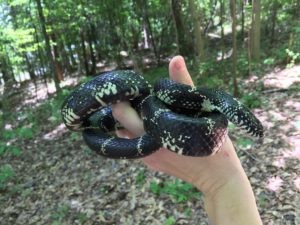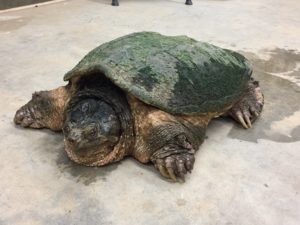The Diana Chronicles: Kingsnake, king snack

When working with wildlife, things don’t always go exactly how you’d expect them. One of the Chattahoochee Nature Center’s Wildlife Technicians, Samantha Kennett, stumbled upon a surprising act of nature through her work with the Urban Kings Project.
This project is a collaboration between CNC, Georgia Department of Natural Resources, and Clemson University researchers into the habits and territory of the Kingsnake, a non-venomous snake that has somehow adapted itself to thrive in urban areas. They aim to tag and track these snakes to determine how they are so successful in this man-made environment.
Samantha was working on a snake nicknamed “Diana.” This adult female Kingsnake joined the study back in May 2019. She was tagged with a radio transmitter and released.

“When we first found Diana she was basking at the edge of a pond in the afternoon sun, and was released close to the spot she was first located,” said Kennett.
Two weeks later Diana was found in unusual location: about three feet from the edge of that same pond… in the water. Samantha came back with rainboots and made her way into the water, only to kick up “one of the largest common snapping turtles I have ever seen” to the surface of the pond. As the snapping turtle swam away, the sound of Diana’s signal in the receiver grew fainter and fainter.
There were a few hours left of daylight, so the Urban Kings team circled the pond to see if maybe, just maybe, they could tell where the turtle went. As luck would have it, the snapper swam directly across the pond and was nestled in the mud not far from dry land. With some serious effort, and lots of mud, they hoisted the unhappy snapper out of the muck and back to CNC for evaluation.

There were a lot of questions: How did the snapper prey on the Kingsnake? Was she basking at the edge of the pond? Did a hawk strike first then mistakenly drop her in the water? Will the snapper be able to pass the transmitter on its own?
For most of these questions, these are answers we will never know. Only one question was answered. The snapping turtle successfully passed the transmitter in mid-June 2019 and was released shortly after back into his pond.
“Though this was an unhappy ending for Diana, this is part of nature; everything’s got to eat,” said Samantha. “Although we’ve set out to learn about Kingsnakes, we’ve now also collected valuable data on the natural history of snapping turtles, and can note this unique observation. In wildlife work, you never know what you’re going to get.”
